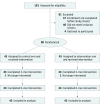Effect of Financial Incentives on Glucose Monitoring Adherence and Glycemic Control Among Adolescents and Young Adults With Type 1 Diabetes: A Randomized Clinical Trial
- PMID: 29059263
- PMCID: PMC6583649
- DOI: 10.1001/jamapediatrics.2017.3233
Effect of Financial Incentives on Glucose Monitoring Adherence and Glycemic Control Among Adolescents and Young Adults With Type 1 Diabetes: A Randomized Clinical Trial
Abstract
Importance: Glycemic control often deteriorates during adolescence and the transition to young adulthood for patients with type 1 diabetes. The inability to manage type 1 diabetes effectively during these years is associated with poor glycemic control and complications from diabetes in adult life.
Objective: To determine the effect of daily financial incentives on glucose monitoring adherence and glycemic control in adolescents and young adults with type 1 diabetes.
Design, setting, and participants: The Behavioral Economic Incentives to Improve Glycemic Control Among Adolescents and Young Adults With Type 1 Diabetes (BE IN CONTROL) study was an investigator-blinded, 6-month, 2-arm randomized clinical trial conducted between January 22 and November 2, 2016, with 3-month intervention and follow-up periods. Ninety participants (aged 14-20) with suboptimally controlled type 1 diabetes (hemoglobin A1c [HbA1c] >8.0%) were recruited from the Diabetes Center for Children at the Children's Hospital of Philadelphia.
Interventions: All participants were given daily blood glucose monitoring goals of 4 or more checks per day with 1 or more level within the goal range (70-180 mg/dL) collected with a wireless glucometer. The 3-month intervention consisted of a $60 monthly incentive in a virtual account, from which $2 was subtracted for every day of nonadherence to the monitoring goals. During a 3-month follow-up period, the intervention was discontinued.
Main outcomes and measures: The primary outcome was change in HbA1c levels at 3 months. Secondary outcomes included adherence to glucose monitoring and change in HbA1c levels at 6 months. All analyses were by intention to treat.
Results: Of the 181 participants screened, 90 (52 [57.8%] girls) were randomized to the intervention (n = 45) or control (n = 45) arms. The mean (SD) age was 16.3 (1.9) years. The intervention group had significantly greater adherence to glucose monitoring goals in the incentive period (50.0% vs 18.9%; adjusted difference, 27.2%; 95% CI, 9.5% to 45.0%; P = .003) but not in the follow-up period (15.3% vs 8.7%; adjusted difference, 3.9%; 95% CI, -2.0% to 9.9%; P = .20). The change in HbA1c levels from baseline did not differ significantly between groups at 3 months (adjusted difference, -0.08%; 95% CI, -0.69% to 0.54%; P = .80) or 6 months (adjusted difference, 0.03%; 95% CI, -0.55% to 0.60%; P = .93).
Conclusions and relevance: Among adolescents and young adults with type 1 diabetes, daily financial incentives improved glucose monitoring adherence during the incentive period but did not significantly improve glycemic control.
Trial registration: clinicaltrials.gov Identifier: NCT02568501.
Conflict of interest statement
Figures


Comment in
-
Motivating Health Behaviors in Adolescents Through Behavioral Economics.JAMA Pediatr. 2017 Dec 1;171(12):1145-1146. doi: 10.1001/jamapediatrics.2017.3464. JAMA Pediatr. 2017. PMID: 29059260 Free PMC article. No abstract available.
Similar articles
-
Effect of Continuous Glucose Monitoring on Glycemic Control in Adolescents and Young Adults With Type 1 Diabetes: A Randomized Clinical Trial.JAMA. 2020 Jun 16;323(23):2388-2396. doi: 10.1001/jama.2020.6940. JAMA. 2020. PMID: 32543683 Free PMC article. Clinical Trial.
-
Process- and Outcome-Based Financial Incentives to Improve Self-Management and Glycemic Control in People with Type 2 Diabetes in Singapore: A Randomized Controlled Trial.Patient. 2021 Sep;14(5):555-567. doi: 10.1007/s40271-020-00491-y. Epub 2021 Jan 25. Patient. 2021. PMID: 33491116 Free PMC article. Clinical Trial.
-
Structured, intensive education maximising engagement, motivation and long-term change for children and young people with diabetes: a cluster randomised controlled trial with integral process and economic evaluation - the CASCADE study.Health Technol Assess. 2014 Mar;18(20):1-202. doi: 10.3310/hta18200. Health Technol Assess. 2014. PMID: 24690402 Free PMC article. Clinical Trial.
-
Psychological interventions to improve self-management of type 1 and type 2 diabetes: a systematic review.Health Technol Assess. 2020 Jun;24(28):1-232. doi: 10.3310/hta24280. Health Technol Assess. 2020. PMID: 32568666 Free PMC article.
-
Executive function, adherence, and glycemic control in adolescents with type 1 diabetes: a literature review.Curr Diab Rep. 2014 Oct;14(10):532. doi: 10.1007/s11892-014-0532-y. Curr Diab Rep. 2014. PMID: 25142717 Review.
Cited by
-
Financial Incentives to Promote Colorectal Cancer Screening: A Longitudinal Randomized Control Trial.Cancer Epidemiol Biomarkers Prev. 2019 Nov;28(11):1902-1908. doi: 10.1158/1055-9965.EPI-19-0039. Epub 2019 Aug 6. Cancer Epidemiol Biomarkers Prev. 2019. PMID: 31387970 Free PMC article. Clinical Trial.
-
Motivating Health Behaviors in Adolescents Through Behavioral Economics.JAMA Pediatr. 2017 Dec 1;171(12):1145-1146. doi: 10.1001/jamapediatrics.2017.3464. JAMA Pediatr. 2017. PMID: 29059260 Free PMC article. No abstract available.
-
Codesigned Shared Decision-Making Diabetes Management Plan Tool for Adolescents With Type 1 Diabetes Mellitus and Their Parents: Prototype Development and Pilot Test.J Particip Med. 2018 May 10;10(2):e8. doi: 10.2196/jopm.9652. J Particip Med. 2018. PMID: 33052121 Free PMC article.
-
Mobile Health and Telehealth Interventions to Increase Physical Activity in Adolescents with Obesity: a Promising Approach to Engaging a Hard-to-Reach Population.Curr Obes Rep. 2021 Dec;10(4):444-452. doi: 10.1007/s13679-021-00456-8. Epub 2021 Oct 1. Curr Obes Rep. 2021. PMID: 34596867 Free PMC article. Review.
-
Patterns of treatment for psychiatric disorders among children and adolescents in Mississippi Medicaid.PLoS One. 2019 Aug 15;14(8):e0221251. doi: 10.1371/journal.pone.0221251. eCollection 2019. PLoS One. 2019. PMID: 31415651 Free PMC article. Clinical Trial.
References
-
- Miller KM, Foster NC, Beck RW, et al. ; T1D Exchange Clinic Network . Current state of type 1 diabetes treatment in the US: updated data from the T1D Exchange Clinic registry. Diabetes Care. 2015;38(6):971-978. - PubMed
-
- Hood KK, Peterson CM, Rohan JM, Drotar D. Association between adherence and glycemic control in pediatric type 1 diabetes: a meta-analysis. Pediatrics. 2009;124(6):e1171-e1179. - PubMed
-
- Standards of medical care in diabetes–2015: summary of revisions. Diabetes Care. 2015;38(suppl):S4. - PubMed
Publication types
MeSH terms
Substances
Associated data
Grants and funding
LinkOut - more resources
Full Text Sources
Other Literature Sources
Medical

